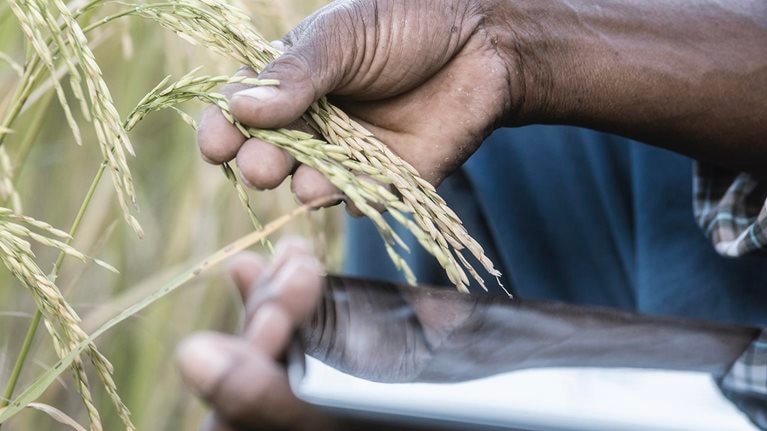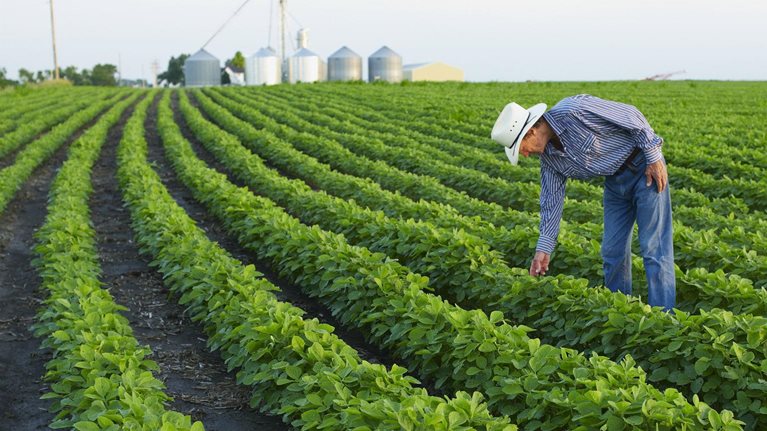The agriculture industry has radically transformed over the past 50 years. Advances in machinery have expanded the scale, speed, and productivity of farm equipment, leading to more efficient cultivation of more land. Seed, irrigation, and fertilizers also have vastly improved, helping farmers increase yields. Now, agriculture is in the early days of yet another revolution, at the heart of which lie data and connectivity. Artificial intelligence, analytics, connected sensors, and other emerging technologies could further increase yields, improve the efficiency of water and other inputs, and build sustainability and resilience across crop cultivation and animal husbandry.
Without a solid connectivity infrastructure, however, none of this is possible. If connectivity is implemented successfully in agriculture, the industry could tack on $500 billion in additional value to the global gross domestic product by 2030, according to our research. This would amount to a 7 to 9 percent improvement from its expected total and would alleviate much of the present pressure on farmers. It is one of just seven sectors that, fueled by advanced connectivity, will contribute $2 trillion to $3 trillion in additional value to global GDP over the next decade, according to research by the McKinsey Center for Advanced Connectivity and the McKinsey Global Institute (MGI) (see sidebar “The future of connectivity”).
Demand for food is growing at the same time the supply side faces constraints in land and farming inputs. The world’s population is on track to reach 9.7 billion by 2050,1 requiring a corresponding 70 percent increase in calories available for consumption, even as the cost of the inputs needed to generate those calories is rising.2 By 2030, the water supply will fall 40 percent short of meeting global water needs,3 and rising energy, labor, and nutrient costs are already pressuring profit margins. About one-quarter of arable land is degraded and needs significant restoration before it can again sustain crops at scale.4 And then there are increasing environmental pressures, such as climate change and the economic impact of catastrophic weather events, and social pressures, including the push for more ethical and sustainable farm practices, such as higher standards for farm-animal welfare and reduced use of chemicals and water.
To address these forces poised to further roil the industry, agriculture must embrace a digital transformation enabled by connectivity. Yet agriculture remains less digitized compared with many other industries globally. Past advances were mostly mechanical, in the form of more powerful and efficient machinery, and genetic, in the form of more productive seed and fertilizers. Now much more sophisticated, digital tools are needed to deliver the next productivity leap. Some already exist to help farmers more efficiently and sustainably use resources, while more advanced ones are in development. These new technologies can upgrade decision making, allowing better risk and variability management to optimize yields and improve economics. Deployed in animal husbandry, they can enhance the well-being of livestock, addressing the growing concerns over animal welfare.
But the industry confronts two significant obstacles. Some regions lack the necessary connectivity infrastructure, making development of it paramount. In regions that already have a connectivity infrastructure, farms have been slow to deploy digital tools because their impact has not been sufficiently proven.
The COVID-19 crisis has further intensified other challenges agriculture faces in five areas: efficiency, resilience, digitization, agility, and sustainability. Lower sales volumes have pressured margins, exacerbating the need for farmers to contain costs further. Gridlocked global supply chains have highlighted the importance of having more local providers, which could increase the resilience of smaller farms. In this global pandemic, heavy reliance on manual labor has further affected farms whose workforces face mobility restrictions. Additionally, significant environmental benefits from decreased travel and consumption during the crisis are likely to drive a desire for more local, sustainable sourcing, requiring producers to adjust long-standing practices. In short, the crisis has accentuated the necessity of more widespread digitization and automation, while suddenly shifting demand and sales channels have underscored the value of agile adaptation.
Current connectivity in agriculture
In recent years, many farmers have begun to consult data about essential variables like soil, crops, livestock, and weather. Yet few if any have had access to advanced digital tools that would help to turn these data into valuable, actionable insights. In less-developed regions, almost all farmwork is manual, involving little or no advanced connectivity or equipment.
Even in the United States, a pioneer country in connectivity, only about one-quarter of farms currently use any connected equipment or devices to access data, and that technology isn’t exactly state-of-the-art, running on 2G or 3G networks that telcos plan to dismantle or on very low-band IoT networks that are complicated and expensive to set up. In either case, those networks can support only a limited number of devices and lack the performance for real-time data transfer, which is essential to unlock the value of more advanced and complex use cases.
Nonetheless, current IoT technologies running on 3G and 4G cellular networks are in many cases sufficient to enable simpler use cases, such as advanced monitoring of crops and livestock. In the past, however, the cost of hardware was high, so the business case for implementing IoT in farming did not hold up. Today, device and hardware costs are dropping rapidly, and several providers now offer solutions at a price we believe will deliver a return in the first year of investment.
These simpler tools are not enough, though, to unlock all the potential value that connectivity holds for agriculture. To attain that, the industry must make full use of digital applications and analytics, which will require low latency, high bandwidth, high resiliency, and support for a density of devices offered by advanced and frontier connectivity technologies like LPWAN, 5G, and LEO satellites (Exhibit 1).

The challenge the industry is facing is thus twofold: infrastructure must be developed to enable the use of connectivity in farming, and where connectivity already exists, strong business cases must be made in order for solutions to be adopted. The good news is that connectivity coverage is increasing almost everywhere. By 2030, we expect advanced connectivity infrastructure of some type to cover roughly 80 percent of the world’s rural areas; the notable exception is Africa, where only a quarter of its area will be covered. The key, then, is to develop more—and more effective—digital tools for the industry and to foster widespread adoption of them.
As connectivity increasingly takes hold, these tools will enable new capabilities in agriculture:
- Massive Internet of Things. Low-power networks and cheaper sensors will set the stage for the IoT to scale up, enabling such use cases as precision irrigation of field crops, monitoring of large herds of livestock, and tracking of the use and performance of remote buildings and large fleets of machinery.
- Mission-critical services. Ultralow latency and improved stability of connections will foster confidence to run applications that demand absolute reliability and responsiveness, such as operating autonomous machinery and drones.
- Near-global coverage. If LEO satellites attain their potential, they will enable even the most remote rural areas of the world to use extensive digitization, which will enhance global farming productivity.
Connectivity’s potential for value creation
By the end of the decade, enhanced connectivity in agriculture could add more than $500 billion to global gross domestic product, a critical productivity improvement of 7 to 9 percent for the industry.5 Much of that value, however, will require investments in connectivity that today are largely absent from agriculture. Other industries already use technologies like LPWAN, cloud computing, and cheaper, better sensors requiring minimal hardware, which can significantly reduce the necessary investment. We have analyzed five use cases—crop monitoring, livestock monitoring, building and equipment management, drone farming, and autonomous farming machinery—where enhanced connectivity is already in the early stages of being used and is most likely to deliver the higher yields, lower costs, and greater resilience and sustainability that the industry needs to thrive in the 21st century (Exhibit 2).

It’s important to note that use cases do not apply equally across regions. For example, in North America, where yields are already fairly optimized, monitoring solutions do not have the same potential for value creation as in Asia or Africa, where there is much more room to improve productivity. Drones and autonomous machinery will deliver more impact to advanced markets, as technology will likely be more readily available there (Exhibit 3).

Potential value initially will accrue to large farms that have more investing power and better incentives to digitize. Connectivity promises easier surveying of large tracts, and the fixed costs of developing IoT solutions are more easily offset in large production facilities than on small family farms. Crops like cereals, grains, fruits, and vegetables will generate most of the value we identified, for similar reasons. Connectivity enables more use cases in these sectors than in meat and dairy, because of the large average size of farms, relatively higher player consolidation, and better applicability of connected technologies, as IoT networks are especially adapted to static monitoring of many variables. It’s also interesting to note that Asia should garner about 60 percent of the total value simply because it produces the biggest volume of crops (see sidebar “About the use-case research”).
Use case 1: Crop monitoring
Connectivity offers a variety of ways to improve the observation and care of crops. Integrating weather data, irrigation, nutrient, and other systems could improve resource use and boost yields by more accurately identifying and predicting deficiencies. For instance, sensors deployed to monitor soil conditions could communicate via LPWAN, directing sprinklers to adjust water and nutrient application. Sensors could also deliver imagery from remote corners of fields to assist farmers in making more informed and timely decisions and getting early warnings of problems like disease or pests.
Smart monitoring could also help farmers optimize the harvesting window. Monitoring crops for quality characteristics—say, sugar content and fruit color—could help farmers maximize the revenue from their crops.
Most IoT networks today cannot support imagery transfer between devices, let alone autonomous imagery analysis, nor can they support high enough device numbers and density to monitor large fields accurately. Narrowband Internet of Things (NB-IoT) and 5G promise to solve these bandwidth and connection-density issues. The use of more and smoother connections between soil, farm equipment, and farm managers could unlock $130 billion to $175 billion in value by 2030.
Use case 2: Livestock monitoring
Preventing disease outbreaks and spotting animals in distress are critical in large-scale livestock management, where most animals are raised in close quarters on a regimen that ensures they move easily through a highly automated processing system. Chips and body sensors that measure temperature, pulse, and blood pressure, among other indicators, could detect illnesses early, preventing herd infection and improving food quality. Farmers are already using ear-tag technology from providers such as Smartbow (part of Zoetis) to monitor cows’ heat, health, and location, or technology from companies such as Allflex to implement comprehensive electronic tracing in case of disease outbreaks.
Similarly, environmental sensors could trigger automatic adjustments in ventilation or heating in barns, lessening distress and improving living conditions that increasingly concern consumers. Better monitoring of animal health and growth conditions could produce $70 billion to $90 billion in value by 2030.
Would you like to learn more about the McKinsey Center for Advanced Connectivity?
Use case 3: Building and equipment management
Chips and sensors to monitor and measure levels of silos and warehouses could trigger automated reordering, reducing inventory costs for farmers, many of whom are already using such systems from companies like Blue Level Technologies. Similar tools could also improve shelf life of inputs and reduce post-harvest losses by monitoring and automatically optimizing storage conditions. Monitoring conditions and usage of buildings and equipment also has the potential to reduce energy consumption. Computer vision and sensors attached to equipment and connected to predictive-maintenance systems could decrease repair costs and extend machinery and equipment life.
Such solutions could achieve $40 billion to $60 billion in cost savings by 2030.
Use case 4: Farming by drone
Agriculture has been using drones for some two decades, with farmers around the world relying on pioneers like Yamaha’s RMAX remote-controlled helicopter to help with crop spraying. Now the next generation of drones is starting to impact the sector, with the ability to survey crops and herds over vast areas quickly and efficiently or as a relay system for ferrying real-time data to other connected equipment and installations. Drones also could use computer vision to analyze field conditions and deliver precise interventions like fertilizers, nutrients, and pesticides where crops most need them. Or they could plant seed in remote locations, lowering equipment and workforce costs. By reducing costs and improving yields, the use of drones could generate between $85 billion and $115 billion in value.
Use case 5: Autonomous farming machinery
More precise GPS controls paired with computer vision and sensors could advance the deployment of smart and autonomous farm machinery. Farmers could operate a variety of equipment on their field simultaneously and without human intervention, freeing up time and other resources. Autonomous machines are also more efficient and precise at working a field than human-operated ones, which could generate fuel savings and higher yields. Increasing the autonomy of machinery through better connectivity could create $50 billion to $60 billion of additional value by 2030.
Additional sources of value
Connected technologies offer an additional, indirect benefit, the value of which is not included in the estimates given in these use cases. The global farming industry is highly fragmented, with most labor done by individual farm owners. Particularly in Asia and Africa, few farms employ outside workers. On such farms, the adoption of connectivity solutions should free significant time for farmers, which they can use to farm additional land for pay or to pursue work outside the industry.
We find the value of deploying advanced connectivity on these farms to achieve such labor efficiencies represents almost $120 billion, bringing the total value of enhanced connectivity from direct and indirect outcomes to more than $620 billion by 2030. The extent to which this value will be captured, however, relies largely on advanced connectivity coverage, which is expected to be fairly low, around 25 percent, in Africa and poorer parts of Asia and Latin America. Achieving the critical mass of adopters needed to make a business case for deploying advanced connectivity also will be more difficult in those regions, where farming is more fragmented than in North America and Europe.

Connected world: An evolution in connectivity beyond the 5G revolution
Implications for the agricultural ecosystem
As the agriculture industry digitizes, new pockets of value will likely be unlocked. To date, input providers selling seed, nutrients, pesticides, and equipment have played a critical role in the data ecosystem because of their close ties with farmers, their own knowledge of agronomy, and their track record of innovation. For example, one of the world’s largest fertilizer distributors now offers both fertilizing agents and software that analyzes field data to help farmers determine where to apply their fertilizers and in what quantity. Similarly, a large-equipment manufacturer is developing precision controls that make use of satellite imagery and vehicle-to-vehicle connections to improve the efficiency of field equipment.
Advanced connectivity does, however, give new players an opportunity to enter the space. For one thing, telcos and LPWAN providers have an essential role to play in installing the connectivity infrastructure needed to enable digital applications on farms. They could partner with public authorities and other agriculture players to develop public or private rural networks, capturing some of the new value in the process.
Agritech companies are another example of the new players coming into the agriculture sphere. They specialize in offering farmers innovative products that make use of technology and data to improve decision making and thereby increase yields and profits. Such agritech enterprises could proffer solutions and pricing models that reduce perceived risk for farmers—with, for example, subscription models that remove the initial investment burden and allow farmers to opt out at any time—likely leading to faster adoption of their products. An Italian agritech is doing this by offering to monitor irrigation and crop protection for wineries at a seasonal, per-acre fee inclusive of hardware installation, data collection and analysis, and decision support. Agritech also could partner with agribusinesses to develop solutions.
Still, much of this cannot happen until many rural areas get access to a high-speed broadband network. We envision three principal ways the necessary investment could take place to make this a reality:
- Telco-driven deployment. Though the economics of high-bandwidth rural networks have generally been poor, telcos could benefit from a sharp increase in rural demand for their bandwidth as farmers embrace advanced applications and integrated solutions.
- Provider-driven deployment. Input providers, with their existing industry knowledge and relationships, are probably best positioned to take the lead in connectivity-related investment. They could partner with telcos or LPWAN businesses to develop rural connectivity networks and then offer farmers business models integrating connected technology and product and decision support.
- Farmer-driven deployment. Farm owners, alone or in tandem with LPWAN groups or telcos, could also drive investment. This would require farmers to develop the knowledge and skills to gather and analyze data locally, rather than through third parties, which is no small hurdle. But farmers would retain more control over data.
How to do it
Regardless of which group drives the necessary investment for connectivity in agriculture, no single entity will be able to go it alone. All of these advances will require the industry’s main actors to embrace collaboration as an essential aspect of doing business. Going forward, winners in delivering connectivity to agriculture will need deep capabilities across various domains, ranging from knowledge of farm operations to advanced data analytics and the ability to offer solutions that integrate easily and smoothly with other platforms and adjacent industries. For example, data gathered by autonomous tractors should seamlessly flow to the computer controlling irrigation devices, which in turn should be able to use weather-station data to optimize irrigation plans.
Connectivity pioneers in the industry, however, have already started developing these new capabilities internally. Organizations prefer keeping proprietary data on operations internal for confidentiality and competitive reasons. This level of control also makes the data easier to analyze and helps the organization be more responsive to evolving client needs.
But developing new capabilities is not the end game. Agriculture players able to develop partnerships with telcos or LPWAN players will gain significant leverage in the new connected-agriculture ecosystem. Not only will they be able to procure connectivity hardware more easily and affordably through those partnerships, they will also be better positioned to develop close relationships with farmers as connectivity becomes a strategic issue. Input providers or distributors could thus find themselves in a connectivity race. If input providers manage to develop such partnerships, they could connect directly with farmers and cut out distributors entirely. If distributors win that race, they will consolidate their position in the value chain by remaining an essential intermediary, closer to the needs of farmers.
The public sector also could play a role by improving the economics of developing broadband networks, particularly in rural areas. For example, the German and Korean governments have played a major role in making network development more attractive by heavily subsidizing spectrum or providing tax breaks to telcos.6 Other regions could replicate this model, accelerating development of connective products by cost-effectively giving input providers and agritech companies assurance of a backbone over which they could deliver services. Eventual deployment of LEO satellite constellations would likely have a similar impact.
Agriculture, one of the world’s oldest industries, finds itself at a technological crossroads. To handle increasing demand and several disruptive trends successfully, the industry will need to overcome the challenges to deploying advanced connectivity. This will require significant investment in infrastructure and a realignment of traditional roles. It is a huge but critical undertaking, with more than $500 billion in value at stake. The success and sustainability of one of the planet’s oldest industries may well depend on this technology transformation, and those that embrace it at the outset may be best positioned to thrive in agriculture’s connectivity-driven future.



